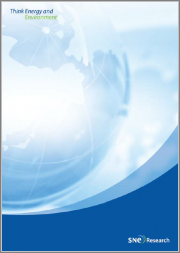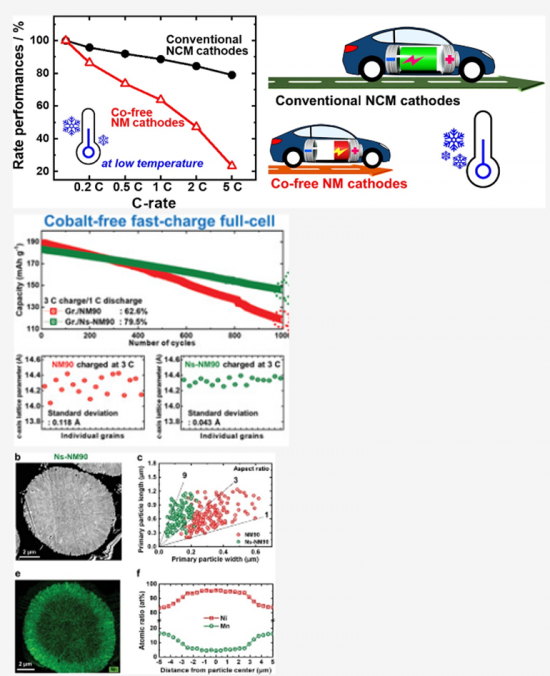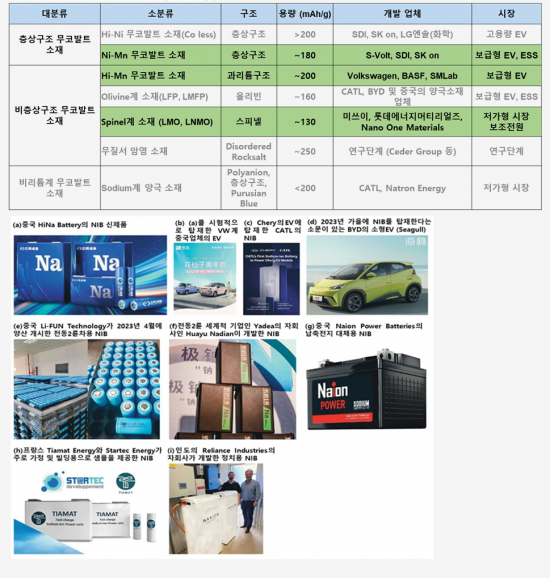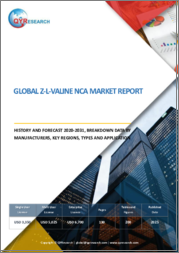
|
시장보고서
상품코드
1302347
<2023> 리튬 이차전지용 무코발트 양극 개발동향 및 시장전망<2023> Development Trends and Market Outlook for Cobalt-free Cathodes for Lithium Secondary Batteries |
||||||
<2023년 신간> 리튬 이차전지용 무코발트(Cobalt-free) 양극 개발동향 및 시장전망
리튬 이차전지는 2010년을 전후하여 전기자동차(EV)에 적용되기 시작하였으며, 현재 “전기 자동차 혁명” 이라고 할 수 있을 정도로 전세계에서 폭발적으로 전기자동차 산업이 발전하고 있으며, 이와 동시에 리튬 이차전지 시장 또한 급속하게 커지고 있습니다.
전지 시장 확대와 연계하여 전지소재 시장 역시 크게 확대되고 있는데, 다른 리튬 이차전지 재료와 달리, 양극 재료의 경우는 Ni, Co 등의 고가 금속이 사용되기 때문에 가격 문제가 발생할 수 있습니다. 물론 Recycle 기술이 활성화되어 고가 금속의 재사용이 가능할 수 있으나, 시장이 크게 확대될 수록, 추가로 더 많은 금속이 필요하기 때문에 시장 확대에 걸림돌이 될 수 있습니다.
전기 자동차의 가장 핵심 성능인 주행 거리는 탑재된 배터리의 에너지 밀도에 의해 결정되며, 배터리의 에너지 밀도는 특히 양극재의 가용 용량과 직결되어 있습니다. NCM 및 NCA 양극재에서는 Ni 함량이 높아지면 가용 용량이 증가하여 에너지 밀도가 향상된다는 장점을 가지고 있기 때문에 양극재의 니켈 함량을 늘리는 고니켈화 연구가 활발하게 진행되고 있지만, 니켈 함량이 증가할수록 가용 용량이 증가하는 대신 수명 안정성 및 열적 안정성이 급격히 하락하는 문제가 발생하고 있습니다.
고니켈화와 더불어 NCM 및 NCA 양극재에서 최근 가장 주목받고 있는 또 다른 이슈는 양극재의 무코발트(Co free)화입니다. 코발트는 전기차 배터리 제조의 가장 많은 비용을 차지하는 양극재의 주요 원료이며, 배터리 수요가 급증하면서 코발트의 가격도 폭발적으로 치솟고 있습니다.
전기 자동차로의 전환이 가속화됨에 따라, 안정적인 원자재 확보 및 저가격화 측면에서 코발트의 사용을 줄이려는 무코발트화 움직임은 배터리 산업에서 새로운 과제로 떠오르고 있습니다. 따라서 이러한 문제를 해결하기 위한 방법으로서는 가장 가격이 비싼 코발트 금속을 아주 소량 사용하거나(Co-less), 궁극적으로는 코발트를 사용하지 않는 고성능 Co free 양극재료 개발이 필요합니다.
SNE Research에 따르면, 무코발트(NMx) 양극재 시장은 ‘22년부터 적용되기 시작하여, ‘23년 전체 양극재 수요의 1%, ‘25년엔 6%, ‘30년엔 12%를 차지할 것으로 전망하고 있다. 한편, 무코발트(NMx)양극재의 가격전망을 보면, ‘23년 $14/kg에서 ‘25년 $12/kg, ‘30년엔 $9/kg으로 하락하여 GAGR -5.5%로 될 것으로 전망되고 있습니다.
본 리포트에서는 이러한 무코발트 양극재 개발에 관한 전체적인 내용을 기술하고 있으며, 좀 더 자세하게는 Global 리튬이차전지 시장과 EV 시장의 분석, 중국/유럽의 리튬이차전지 시장과 EV 현황을 분석하였고, 리튬이차전지용 양극재 개발동향과 전망을 다루면서, 핵심인 무코발트 양극재 기술개발 동향과 전망을 기술하였습니다. 특히, 무코발트 양극재 개발 및 적용에 앞서가고 있는 중국업체 및 국내업체의 기술 및 특허까지 분석 범위를 넓혀 가면서 무코발트 양극재의 중요 기술을 파악하고자 했습니다.
아무쪼록 본 리포트가 무코발트의 기술 및 앞으로의 전망에 대하여 관심이 있는 분들에게 insight와 통찰력을 제시함은 물론 이를 둘러싼 산업을 이해하는데 큰 도움이 되길 진심으로 바랍니다.
본 보고서의 Strong Point
- ①무코발트 양극재에 대한 전반적인 개요 및 풍부한 기술내용
- ②무코발트 양극재의 개발사례를 통한 설계, 합성 시 고려 사항
- ③무코발트 양극재의 개발동향 및 향후 기술 및 시장 전망 제시
- ④비리튬계 무코발트 전지인 나트륨이온전지에 대한 핵심 기술 및 전망 제시
- ⑤무코발트 양극재 주요 개발기업 및 연구기관의 특허 분석
목 차
1. 리튬 이차전지 및 EV 시장 현황
- 1.1 리튬 이차전지 시장 현황 및 전망
- 1.1.1 Global 리튬 이차전지 시장 현황
- 1.1.2 Global xEV 리튬 이차전지 수요 전망
- 1.1.3 Global xEV용 리튬 이차전지 시장 전망
- 1.1.4-8 중국의 리튬 이차전지 시장 현황
- 1.1.9-10 유럽의 리튬 이차전지 시장 현황
- 1.1.11 한국의 리튬 이차전지 시장 현황
- 1.1.12 일본의 리튬 이차전지 시장 현황
- 1.2 전기자동차 시장 현황 및 전망
- 1.2.1 Global 전기 자동차 시장 현황 및 전망
- 1.2.2 중국 전기자동차 시장 현황 및 전망
- 1.2.3 유럽 전기자동차 시장 현황 및 전망
- 1.2.3 한국의 전기자동차 시장 현황 및 전망
- 1.2.4 일본의 전기자동차 시장 현황 및 전망
2. 리튬 이차전지용 양극 현황
- 2.1 리튬 이차전지용 양극 개발 현황
- 2.1.1 리튬 이차전지용 양극 종류
- 2.1.2 고전압 양극 기술
- 2.1.3 LFP/LMFP, Blade battery
- 2.1.4 NCM단결정(Single crystal)
- 2.1.5 Bimodal기술
- 2.1.6 4원계 NCMA기술
- 2.1.7 전세계 양극재 시장 수요 전망
- 2.1.8 중국의 양극 종류별 시장규모 예측
- 2.2 리튬 이차전지용 양극 원재료 현황
- 2.2.1 Co, Ni금속 가격 현황
- 2.2.2 Co, Ni 금속 주요국 생산량 및 매장량 현황
- 2.2.3 주요국 리튬 생산량 및 매장량 현황
- 2.2.4 LiOH, Li2CO3 가격 현황
- 2.2.5 NCM523/811 가격 현황
- 2.2.6 Battery가격($/Wh)변동 추이
3. 무코발트(Co-free) 양극 개발 현황
- 3.1 무코발트(Co-free) 양극 소재 개요
- 3.1.1-2 무코발트 양극소재 필요성, 문제
- 3.1.3-4 무코발트 양극소재 분류 및 특징
- 3.2 층상구조 무코발트 양극 소재
- 3.2.1 층상구조 양극소재에서의 코발트의 역할
- 3.2.2 하이니켈 무코발트 양극소재 특징 및 개발 현황
- 3.2.3 NMx 무코발트 양극소재 특징 및 개발 현황
- 3.3 비층상구조 무코발트 양극 소재
- 3.3.1 하이망간계 양극소재 개발 현황
- 3.3.2 올리빈계 (LFP, LMFP) 양극소재 개발 현황
- 3.3.3 스피넬계(LMO, LNMO) 양극소재 개발 현황
- 3.3.4 무질서 암염구조 소재 개발 현황
- 3.4 SVOLT사와 무코발트(Co-free) 사업화 현황 및 전망
- 3.4.1 SVOLT 양극재 개발 역사
- 3.4.2 SVOLT 사업영역
- 3.4.3 향후 기술개발 계획
4. 비리튬계 무코발트: NiB 개발 현황
- 4.1 NiB(Na Ion Battery) 개요
- 4.1.1 나트륨 이차전지 원리
- 4.1.2 나트륨 이차전지 vs. 리튬이차전지 비교
- 4.1.3 나트륨 이차전지의 가격 경쟁력 분석
- 4.1.4 나트륨 이차전지의 주요 재료 후보
- 4.2 NiB 재료 개발 및 현황
- 4.2.1 나트륨 이차전지용 양극 개발 현황
- 4.2.2 나트륨 이차전지용 음극 개발 현황
- 4.2.3 나트륨 이차전지 개발 현황
- 4.2.4 나트륨 이차전지의 향후 전망
- 4.2.5 나트륨 이차전지의 리서치사 별 시장 전망
5. 무코발트 양극재 시장 전망
- 5.1 무코발트 양극재 시장 전망(’18 - ‘30)
- 5.1.1 NMx 양극재 시장 전망(1)
- 5.1.1 NMx 양극재 시장 전망(2)
- 5.2 무코발트 양극재 수요 전망 (’18-’30년)
- 5.2.1 NMx 양극재의 수요 전망(1)
- 5.2.1 NMx 양극재의 수요 전망(2)
- 5.3 무코발트 양극재 가격 전망 (’18-’30년)
- 5.3.1 NMx 양극재 가격 전망(1)
- 5.3.1 NMx 양극재 가격 전망(2)
6. 무코발트 양극재 적용 전지 특허 분석
- 6.1 한양대
- 6.2 엘지
- 6.3 포스코
- 6.4 SVOLT
- 6.5 Univ. Texas
- 6.6 Nano One
Lithium rechargeable batteries began to be applied to electric vehicles (EVs) around 2010, and now, in what can be described as an "electric vehicle revolution," the EV industry is exploding around the world, and the market for lithium rechargeable batteries is growing rapidly.
Unlike other lithium secondary battery materials, cathode materials use expensive metals such as Ni and Co, which can cause price problems. It is possible to reuse expensive metals through the implementation of recycling technologies, but the larger the market, the more additional metals are required, which can be a barrier to market expansion.
The driving range, which is the most important performance of an electric vehicle, is determined by the energy density of the battery it is equipped with. The energy density of a battery is directly related to the available capacity of the cathode material. In NCM and NCA anodes, higher Ni content has the advantage of increasing the usable capacity and thus improving the energy density, so high-nickelization research has been actively conducted to increase the nickel content of the cathode, but the increase in nickel content is accompanied by a sharp decrease in life stability and thermal stability at the expense of increased usable capacity.
In addition to high-nickelization, another issue that is attracting attention in NCM and NCA cathode materials is the cobalt-free (Co free) cathode material. Cobalt is a major raw material for cathode materials that accounts for the most costs in the manufacture of electric vehicle batteries. As the demand for batteries is increasing rapidly, the price of cobalt is also skyrocketing.
As the transition to electric vehicles accelerates, the movement to reduce the use of cobalt in order to secure stable raw materials and lower prices is emerging as a new challenge in the battery industry. Therefore, in order to solve these problems, it is necessary to use the most expensive cobalt metal in very small amounts (Co-less), or ultimately, high-performance Co free cathode materials that do not use cobalt.
According to SNE Research, the market for cobalt-free (NMx) cathode materials began to be applied in 2022, and is expected to account for 1% of total cathode material demand in 2023, 6% in 2025, and 12% in 2030. Meanwhile, the price outlook for cobalt-free (NMx) cathode materials is expected to decline from $14/kg in 2023 to $12/kg in 2025, and $9/kg in 2030, with a compound annual growth rate (CAGR) of -5.5%.
This report provides a comprehensive overview of the development of cobalt-free cathode materials. It provides a detailed analysis of the global lithium-ion battery market and electric vehicle (EV) market, as well as the Chinese and European lithium-ion battery market and EV status. The report also discusses the development trends and prospects of cathode materials, and summarizes the development trends and prospects of cobalt-free cathode materials. In particular, the report analyzes the technologies and patents of Chinese and domestic companies that are leading the development and application of cobalt-free cathode materials, in order to identify the key technologies of cobalt-free cathode materials.
This report by SNE Research is expected to provide insight into the technology and market of cobalt-free cathode materials, as well as be a great help in understanding the industry surrounding it.
Strong Points of the Report:
- 1. A comprehensive overview of cobalt-free cathode materials and abundant technical content.
- 2. Considerations for design and synthesis through case studies of cobalt-free cathode materials
- 3. Presentation of the development trends and future technological and market outlook of cobalt-free cathode materials
- 4. Presentation of key technologies and prospects of sodium-ion batteries, which are non-lithium cobalt batteries
- 5. Patent analysis of major cobalt-free cathode material development companies and research institutes.


Table of Contents
1. State of the Lithium-ion Battery and EV Market
- 1.1. Lithium-ion Battery Market Status and Outlook
- 1.1.1. Global Lithium-ion Battery Market Status
- 1.1.2. Global xEV Lithium-ion Battery Demand Outlook
- 1.1.3. Global Lithium-ion Battery Market Outlook for xEVs
- 1.1.4~8. China's Lithium-ion Battery Market Status
- 1.1.9~10. Europe's Lithium-ion Battery Market Status
- 1.1.11. South Korea's Lithium-ion Battery Market Status
- 1.1.12. Japan's Lithium-ion Battery Market Status
- 1.2. Electric Vehicle Market Status and Outlook
- 1.2.1. Global EV Market Status and Outlook
- 1.2.2. China's EV Market Status and Outlook
- 1.2.3. Europe's EV Market Status and Outlook
- 1.2.4. South Korea's EV Market Status and Outlook
- 1.2.5. Japan's EV Market Status and Outlook
2. State of Lithium Cathode for Secondary Battery
- 2.1. Status of Lithium Cathode Development for Secondary Battery
- 2.1.1. Types of Cathodes for Lithium-ion Batteries
- 2.1.2. High Voltage Cathode Technology
- 2.1.3. LFP/LMFP, Blade battery
- 2.1.4. NCMSingle Crystal
- 2.1.5. Bimodal Technology
- 2.1.6. Four-element NCMA Technology
- 2.1.7. Global Cathode Materials Market Demand Forecast
- 2.1.8. Market Size Forecast by Cathode Type in China
- 2.2. Status of Lithium-ion Battery Cathode Raw Materials
- 2.2.1. Co, Ni Metal Price Status
- 2.2.2. Production and Reserves of Co and Ni Metals in Major Countries
- 2.2.3. Lithium Production and Reserves in Major Countries
- 2.2.4. LiOH, Li2CO3 Price Status
- 2.2.5. NCM523/811 Price Status
- 2.2.6. Battery Price ($/Wh) Changes
3. Status of Cobalt-free Cathode Development
- 3.1. Overview of Co-free Cathode Materials
- 3.1.1~2. Cobalt-free Cathode Materials, Need and Problems
- 3.1.3~4. Cobalt-free Cathode Material Classification and Characteristics
- 3.2. Layered Structure Cobalt-free Cathode Materials
- 3.2.1. The Role of Cobalt (Co) in Layered Cathode Materials
- 3.2.2. Features and Development Status of Hi-Ni Cobalt-free Cathode Materials
- 3.2.3. Features and Development Status of Ni-Mn Based Cobalt-free Cathode Materials (NMx)
- 3.3. Non-layered Cobalt-free Cathode Materials
- 3.3.1. Development Status of Hi-Mn-based Cathode Materials
- 3.3.2. Development Status of Olivine-based (LFP, LMFP) Cathode Materials
- 3.3.3. Development Status of Spinel-based (LMO, LNMO) Cathode Materials
- 3.3.4. Development Status of Disordered Rock Salt Structure Materials
- 3.4. SVOLT and Outlook for Cobalt-free Commercialization
- 3.4.1. SVOLT History of Cobalt-free Cathode Development
- 3.4.2. SVOLT Business Scope
- 3.4.3. Future Technology Development Plan
4. Non-lithium-based Cobalt-free: NiB Development Status
- 4.1. Na Ion Battery (NiB) Overview
- 4.1.1. Principle of Sodium-Ion Battery
- 4.1.2. Sodium-Ion Battery vs. Lithium Secondary Battery Comparison
- 4.1.3. Analyzing the Price Competitiveness of Sodium-Ion Batteries
- 4.1.4. Leading Material Candidates for Sodium-Ion Batteries
- 4.2. NiB Material Development and Status
- 4.2.1. Cathode Development for Sodium-Ion Batteries
- 4.2.2. Anode Development for Sodium-Ion Batteries
- 4.2.3. Sodium-Ion Battery Development Status
- 4.2.4. The Future Prospects for Sodium-Ion Batteries
- 4.2.5. Market Outlook for Sodium-Ion Batteries by Research Firm
5. Cobalt-free Cathode Market Outlook
- 5.1. Cobalt-free Cathode Market Forecast ('18 ~ '30)
- 5.1.1. NMx Cathode Market Outlook(1)
- 5.1.1. NMx Cathode Market Outlook(2)
- 5.2. Cobalt-free Cathode Demand Forecast ('18 ~ '30)
- 5.2.1. Market Demand Outlook for NMx cathodes (1)
- 5.2.1. Market Demand Outlook for NMx cathodes (2)
- 5.3. Cobalt-free Cathode Price Forecast ('18 ~ '30)
- 5.3.1. NMx Cathode Price Outlook (1)
- 5.3.1. NMx Cathode Price Outlook (2)
6. Battery Patent Analysis for Cobalt-free Cathode Materials
- 6.1. Hanyang University
- 6.2. LG
- 6.3. POSCO
- 6.4. SVOLT
- 6.5. Univ. Texas
- 6.6. Nano One
(주말 및 공휴일 제외)


















